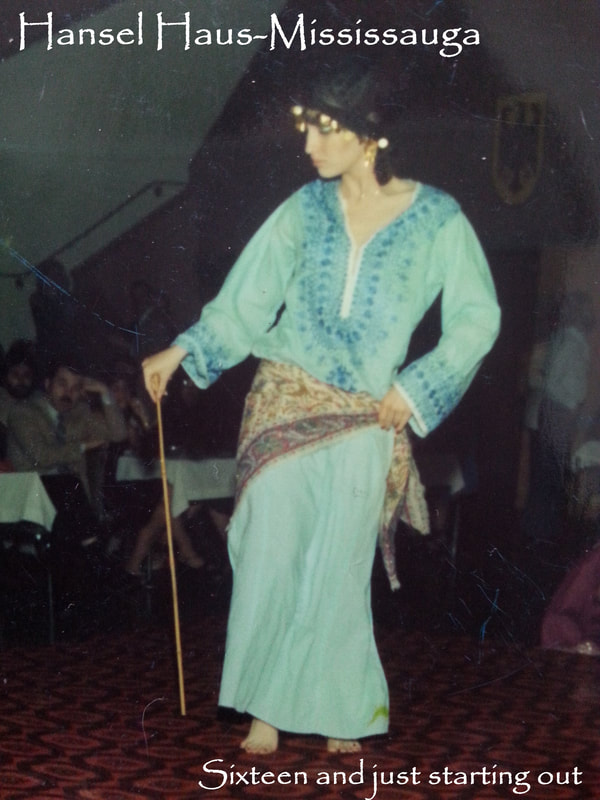|
I cannot think of belly dance without thinking of Dora Nasr. A beautiful Egyptian lady that attended the same belly dance class I did for a short period of time. She was from an era before religious leaders of Islam gained a stronger hold in the country. She wore tailored skirted suits. She did not cover her head. She was an engineer. She was strong and she was intelligent. She made it clear to our instructor that she would never perform in public; culturally that was unacceptable. She was strong in her belief of what was right and wrong. Dora had an innate femininity and grace and had a confidence that had just as much to do with her as a woman as it did with her accomplishments; she knew who she was. That was the impression she made on 16-year-old me.
I think for every dancer there is that one person that changes the trajectory of their journey. This person turns up seemingly out of nowhere, believes in you and genuinely wants to help you with no ulterior motive. This person just as quickly is gone from your life leaving an indelible impression. Dora was that person for me. I was 15 when my mother dragged me to my first class because she felt I needed to learn how to be more 'lady like'. I was thrown into a class where everyone was much older than I was. I entered the class feeling completely out of place. Then the music began. As always, music is a driving force in what I do. I ended up enjoying the class and staying. Fast forward to year 2 where I was picked to do a solo. I cannot remember how I was picked. I do not even remember if I was given the choice or just told to do it! I don’t remember how I picked the music or if I picked the music. I was left trying to pull something together with little or no direction or experience. This is where Dora came in. I can’t quite remember but I feel that during a class she asked me about the dance and maybe how I was doing. My first clear memory was her in our apartment and me dancing. Somehow, miraculously, she was there. I think it was only one afternoon. It was an afternoon that changed my life. My biggest problem at that time was that I would freeze. She just would not let me. ‘Keep dancing, keep dancing’ she would say. She never once said that is bad, or incorrect or out of step or off beat. She just said, ‘Dance!’ I remember that unlike most of my life I did not feel intimidated or judged. I felt safe, I felt helped, I felt encouraged. She herself did not dance. She did not tell me what or how to do anything. She encouraged me to keep moving and work it out in my body. She told me to keep what I was doing with my mouth. I had no idea I was pursing my lips in concentration. She said it was good. I can’t remember the words she used but with her hand gestures and comments I understood it was becoming and maybe flirtatious. Dora encouraged me that day and then she told me about the ‘glue’. The glue is the secret. That which joins the steps and changes them from mere steps to dance. The glue is “the story between the steps” to quote Yasmina Ramzy. The glue is the nuance. The glue is the emotion. The glue is what keeps the story going and pulls in the audience. This I learned years later. At that time, I just knew it was the glue. Dora also told me about having, ‘It’. She explained that a young girl cannot have ‘It’ it is something that only life can give you. Some might think this was a bad thing to say but for me it lifted a big burden off my shoulders. I was not to try to be or act like something I was not. She kept me honest in my dance and she allowed me to stay true to who I was. I am forever grateful that this beautiful, busy working woman took time to help a disingenuous young girl. I carry Dora in my heart, mind and soul. I carry her when I dance. I will never forget her. One afternoon. It was one afternoon. This might be my one and only blog, but I needed to write down some things. I have had thoughts swirling in my mind due to some conversations I had recently. Here are some random thoughts as I wait to hear about new lockdown measures… I had the opportunity to speak to an out-of-town belly dance sister this week. She shared with me that she had considered giving up the dance due to attacks about appropriation. I still cannot put into words how I felt when she shared this with me. What I can share is this, this is the dancer that my Egyptian friends have been excitedly waiting to see perform again. This is the dancer they felt imbued the dance with Egyptian feel and style. A beautiful, respectful dance artist. Fortunately, I was able to share the excitement and anticipation of my Egyptian friends. Due to Covid we were forced to cancel the 2019 show, so it has been a long wait. I wish she could see how their eyes light up as they remember her performance. I wish she could see how energized they become! At one time I joined an on-line group supposedly about promoting and uplifting the dance. I was shocked to find only judgment and hatred. When I expressed the notion that my Middle Eastern friends loved and enjoyed our dancing, when I shared one of their comments “if you feel it, dance!” I was told by a North American dancer that “they didn’t know any better”. This is the height of privilege. To decide that you know better than the people of the culture. To decide that you as a North American get to sit in judgment. I had a friend tell me I could not legitimately discuss appropriation because I was a belly dancer and the fact that I am means I am appropriating the art form. This is someone that will play the blues despite its roots. As a dancer that has taught at studios teaching hip hop, jazz, ballet etc. and as someone that has attended many yoga classes run by non-Indian instructors, I am puzzled as to why belly dance is considered appropriation while this is not. I am not talking about authentic folklore and regional dances I refer to belly dance as a whole. I remember sitting in an audience raptly listening to Mahmoud Reda founder of the Reda Troupe speaking about his life and career. He talked about the dance and the art. About how creativity has no bounds. About attempts to restrict him as a dancer and an artist. About how he studied ballet. He encouraged us to not allow ourselves to be restricted as artists. His audience was mostly made up of North American dancers. To this day his choreographies are performed in Egypt and the Reda Troupe exists. I love this dance. Not the over sexualized, over the top, sensationalized stuff. I love the dancer that digs deep. The dancer that dares to show you who she is when performing. That moves to the music in a way that shows a connection and understanding of the depth of this dance, culture, and history. I love the new dancers discovering themselves and the rhythms. I love the sounds and the layers. I love the intricacy and I love the simplicity. And I love, love, love when the light comes on and they ‘get it’. I love when the thirst for knowledge kicks in and suddenly it is not only about the dance anymore. It becomes about people and culture, about sorrows and hardship and joy and life. It becomes about communication and extending a hand in friendship. My final thought is this… if you love this dance keep going. Do not let the naysayers stop you. Listen and engage with and learn from the people of the culture. When you know better, do better. Accept that every time you do something great and not so great, every time you step out on that stage there will be critics. The question is do you love it enough to risk it? Do you love it enough to leave your heart out on that dance floor? I can promise you this, the right people will recognize the gift. Keep dancing my friends. Dance for joy. Dance for sorrow. Dance for life! https://www.theatlantic.com/entertainment/archive/2015/10/the-dos-and-donts-of-cultural-appropriation/411292/ |
Karen Elizabeth aka Na'ema of Aaliyah DanceI began oriental dance when I was 15. I love everything about it. It made me who I am today. Archives
January 2022
Belly Dance,
|
Live Chat Support
×
Connecting

You:
::content::
::agent_name::
::content::
::content::
::content::

 RSS Feed
RSS Feed